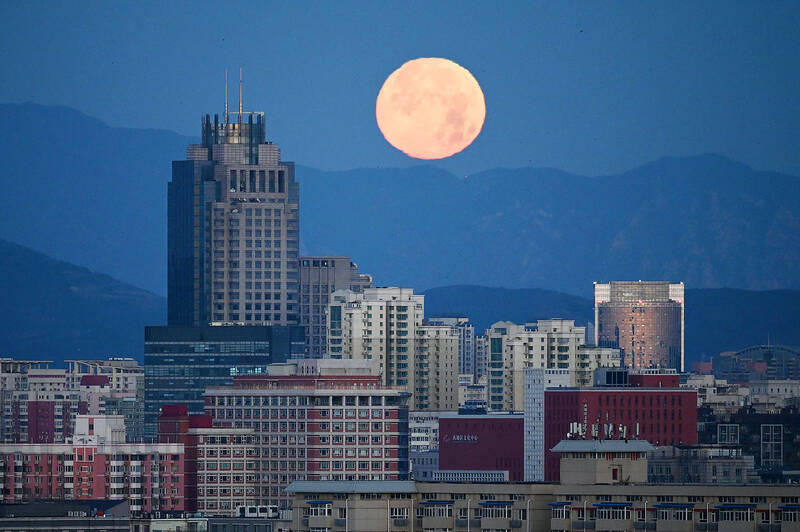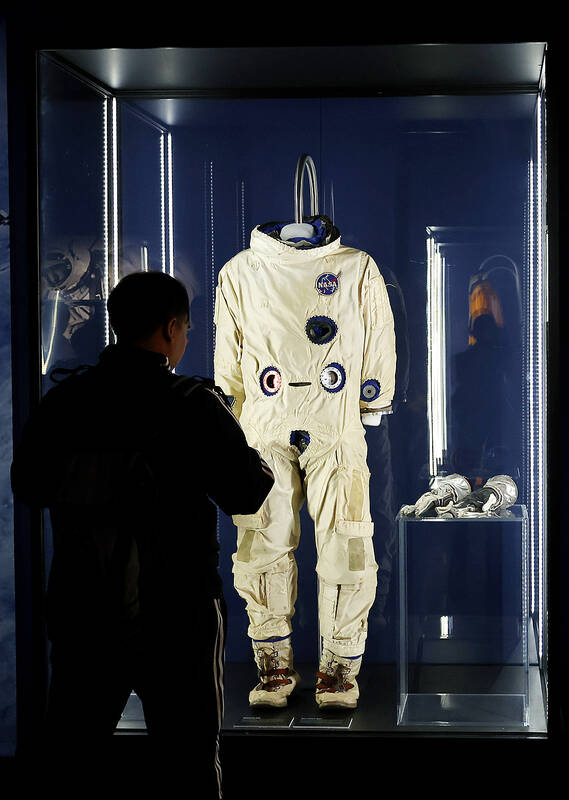Just as the outline of an iron-age hut or remains of a Roman sword cause excitement today, archaeologists of the future could be brushing Martian dust off metal and marveling at one of Nasa’s rovers.
Researchers have said that such instruments, as well as other forms of human activity on Mars, including landing sites and debris, must be preserved as part of the archaeological record of space exploration.
“All of this material, including the trackways and even discarded pieces of this equipment, represent the material record of our species’ first steps across our solar system,” said Justin Holcomb, of the University of Kansas.

Photo: AFP
Writing in the journal Nature Astronomy, Holcomb and colleagues say natural weathering, meteoroid impacts, unplanned crashes, flyovers or near-site landing events put such “space heritage” at risk — adding that any future accidental destruction would be permanent.
“We do not need specific missions aimed at preservation, just to design missions that consider limiting any damage to previous missions,” Holcomb said, although he suggested in some cases, as on Earth, projects could continue once documentation is made.
While the team say there should be further investigations into concerns that human material on the red planet is “space trash” that could pose a risk both to the Martian environment and future missions, they maintain that such items should be protected “because they record the legacy of space exploration by our species”.

Photo: EPA-EFE
It would not be the first time one era’s junk has become another’s treasure: archaeologists today often excavate middens — rubbish heaps created by our ancestors.
Just as our species once left Africa, we are currently beginning the process of leaving Earth, Holcomb said.
“Each dispersal event represents key moments in our species’ long history of migration,” he added. “The material left behind, whether it be handaxes in Tanzania or rovers on Mars, represent material footprints recording our history. We believe preservation efforts ensure that history is accurately documented for future generations.”

Photo: EPA-EFE
Holcomb and colleagues add that while a UN register keeps track of objects sent into space, there is no systematic approach for recording and mapping space heritage on Mars.
But the team’s concerns extend beyond the red planet, noting that space heritage includes Apollo 11’s Tranquility base, where Neil Armstrong and Buzz Aldrin took the first human steps on the moon in 1969, and the USSR’s Venera 7 mission to Venus in 1970, the first time a spacecraft successfully landed on another planet.
They are not alone: in 2019 Jan Worner, then head of the European Space Agency, called for the Tranquility base to be granted special heritage status.
“We have to preserve the milestones in all human fields, including space,” he said.
Martin Rees, astronomer royal, agreed that it is important to preserve and protect such sites, adding that the robotic vehicles already on Mars will remain there and should be protected.
“There may be replicas in museums, but the real things are special,” he said.
But Rees suggested not everything needs to be preserved.
“I’m not enthusiastic about putting effort into retrieving debris spread over the surface — though it’s important to avoid adding to the amount of such debris, to avoid pollution,” he said.
Jon Wade, associate professor of planetary materials at the University of Oxford, said that unlike missions sent to Venus, many objects on the moon and Mars will outlast humanity.
But, he noted, the lack of witnesses means it will be hard to know if a space heritage site has been damaged by future activity while, as on Earth, economic reasons can always be made for certain projects – such as strip mining an extraterrestrial heritage site.
“I’d argue science doesn’t have a viewpoint on if, and how, we should preserve these sites, rather it’s a wider cultural question where one group shouldn’t assume they know best,” he said.
“On the other hand, stuff on Mars isn’t exactly in danger of being over-run with tourists in the immediate future. Mars is, frankly, like the solar system’s worst pub — empty, cold, dry and lacking in much atmosphere, so I for one ain’t in any rush to visit.”

In the March 9 edition of the Taipei Times a piece by Ninon Godefroy ran with the headine “The quiet, gentle rhythm of Taiwan.” It started with the line “Taiwan is a small, humble place. There is no Eiffel Tower, no pyramids — no singular attraction that draws the world’s attention.” I laughed out loud at that. This was out of no disrespect for the author or the piece, which made some interesting analogies and good points about how both Din Tai Fung’s and Taiwan Semiconductor Manufacturing Co’s (TSMC, 台積電) meticulous attention to detail and quality are not quite up to

April 21 to April 27 Hsieh Er’s (謝娥) political fortunes were rising fast after she got out of jail and joined the Chinese Nationalist Party (KMT) in December 1945. Not only did she hold key positions in various committees, she was elected the only woman on the Taipei City Council and headed to Nanjing in 1946 as the sole Taiwanese female representative to the National Constituent Assembly. With the support of first lady Soong May-ling (宋美齡), she started the Taipei Women’s Association and Taiwan Provincial Women’s Association, where she

Chinese Nationalist Party (KMT) Chairman Eric Chu (朱立倫) hatched a bold plan to charge forward and seize the initiative when he held a protest in front of the Taipei City Prosecutors’ Office. Though risky, because illegal, its success would help tackle at least six problems facing both himself and the KMT. What he did not see coming was Taipei Mayor Chiang Wan-an (將萬安) tripping him up out of the gate. In spite of Chu being the most consequential and successful KMT chairman since the early 2010s — arguably saving the party from financial ruin and restoring its electoral viability —

It is one of the more remarkable facts of Taiwan history that it was never occupied or claimed by any of the numerous kingdoms of southern China — Han or otherwise — that lay just across the water from it. None of their brilliant ministers ever discovered that Taiwan was a “core interest” of the state whose annexation was “inevitable.” As Paul Kua notes in an excellent monograph laying out how the Portuguese gave Taiwan the name “Formosa,” the first Europeans to express an interest in occupying Taiwan were the Spanish. Tonio Andrade in his seminal work, How Taiwan Became Chinese,